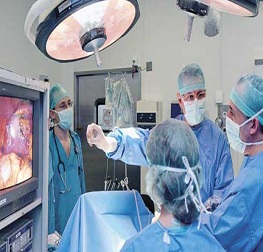- 9975035364
- [email protected]
HYSTEROSCOPY

What is Hysteroscopy?
A hysteroscope is an endoscope that carries optical and light channels or fibers. It is introduced in a sheath that provides an inflow and outflow channel for insufflation of the uterine cavity. In addition, an operative channel may be present to introduce scissors, graspers or biopsy instruments. A hysteroscopic resectoscope is similar to a transurethral resectoscope and allows entry of an electric loop to shave off tissue, for instance to eliminate a fibroid. A contact hysteroscope is a hysteroscope that does not use distention media.
Procedure
Hysteroscopy has been done in the hospital, surgical centers and the office. It is best done when the endometrium is relatively thin, that is after a menstruation. Diagnostic can easily be done in an office or clinic setting on suitably selected patients. Local anesthesia can be used. Simple operative hysteroscopy can also be done in an office or clinic setting. Analgesics are not always necessary. A paracervical block may be used using a Lidocaine injection in the upper part of the cervix. The patient is in a lithotomy position during the procedure. Hysteroscopic intervention can also be done under general anesthesia (endotracheal or laryngeal mask) or Monitored Anesthesia Care(MAC). Prophylactic antibiotics are not necessary.
Cervical dilation
The diameter of the hysteroscope is generally too large to conveniently pass the cervix directly, thereby necessitating cervical dilation to be performed prior to insertion. Cervical dilation can be performed by temporarily stretching the cervix with a series of dilators of increasing diameter. Misoprostol prior to hysteroscopy for cervical dilation appears to facilitate an easier and uncomplicated procedure only in premenopausal women.
Insertion and inspection
The hysteroscope with its sheath is inserted transvaginally guided into the uterine cavity, the cavity insufflated, and an inspection is performed.